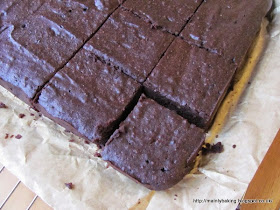 I've made a sort of resolution to use up all the odds and ends in my baking store cupboard before I buy anything new. You know the sort of thing - half used packets of nuts, packs of dried fruit bought on special offer, but now approaching the 'best-before' date, and things bought on a whim but never used. I don't expect the resolution to last long if I really feel the need to make something for which I don't have the right ingredients, but for the moment, there's a ban on new purchases.
I've made a sort of resolution to use up all the odds and ends in my baking store cupboard before I buy anything new. You know the sort of thing - half used packets of nuts, packs of dried fruit bought on special offer, but now approaching the 'best-before' date, and things bought on a whim but never used. I don't expect the resolution to last long if I really feel the need to make something for which I don't have the right ingredients, but for the moment, there's a ban on new purchases.This flapjack is a perfect example of the sort of baking I should be doing - it used oats from a source which I won't use again, as the flakes are too small, chocolate which was past it's 'best-before' date (but still in good condition), and a whole pack of dried cherries which had been in the store cupboard for ages.
I adapted my usual flapjack recipe, reducing it to 2/3, so that I could make a smaller batch. I reduced the butter and added melted chocolate, and also added some desiccated coconut along with the oats, as the total (increased) amount of butter and chocolate would take a larger amount of absorbent ingredients.
 Ingredients
Ingredients100g chocolate (I used 30g of 100% cacao and 70g of 85% plain chocolate)
100g unsalted butter
65g golden syrup
100g light muscovado sugar
240g rolled oats
100g dried cherries - roughly chopped
50g desiccated coconut
Method
Pre-heat oven to 180C and line a 20cm (8") square shallow tin with baking parchment.
Melt the chocolate, butter, golden syrup and sugar together in a large saucepan, stirring until smooth and hot, but not allowing to boil.
Stir in the remaining dry ingredients and mix well to distribute the fruit and coconut evenly. Tip the mixture into the baking tin and spread to an even layer, pressing down well with the back of a spoon.
Bake for 25 minutes, then cool slightly before marking into 16 squares with a sharp knife. Cool completely before removing from tin.
 These flapjacks tasted really good - using such dark, bitter chocolate cut through the sweetness of the sugar and syrup, and the dried cherries were quite tart too. The flapjacks were just the way I like them - chewy and not too crisp. If you prefer crisp flapjacks, then a few minutes longer baking time usually works.
These flapjacks tasted really good - using such dark, bitter chocolate cut through the sweetness of the sugar and syrup, and the dried cherries were quite tart too. The flapjacks were just the way I like them - chewy and not too crisp. If you prefer crisp flapjacks, then a few minutes longer baking time usually works.













